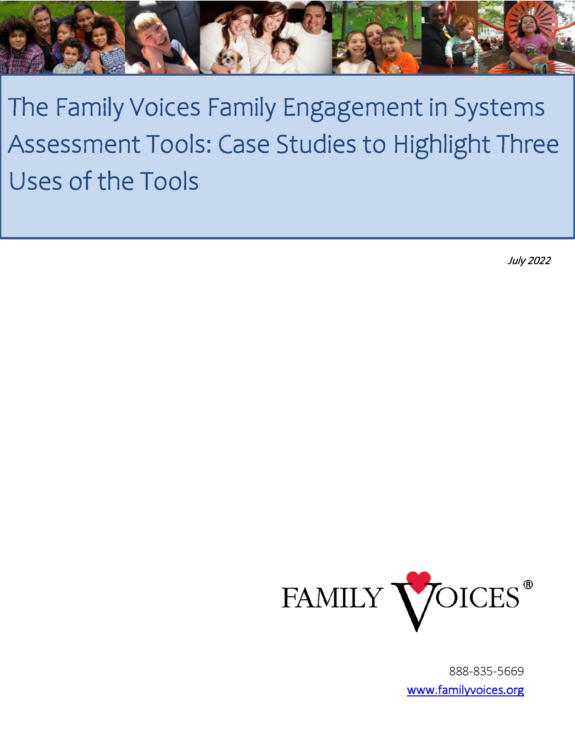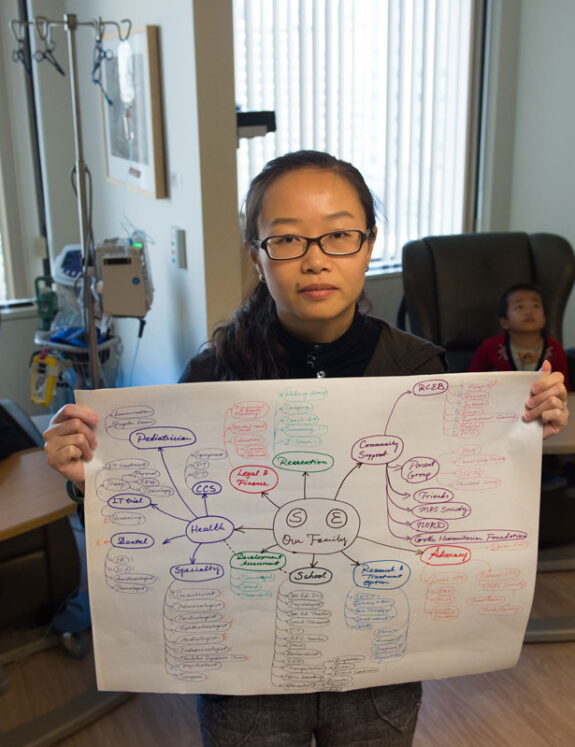Using the Family Engagement in Systems Assessment Tool: A Real World Example
The Family Voices Family Engagement in Systems Assessment Tool (FESAT), available in English and Spanish, can be used for planning, assessing, and improving family engagement in systems-level initiatives. This interview describes the experience of implementing this approach in a statewide Title V program and offers recommendations for use. Also see the FESAT Case Studies.
Strengthening family engagement is a priority for many state Title V programs as part of their Maternal and Child Health Block Grant five-year State Action Plans. To address this focus, Children’s Rehabilitation Service (CRS), Alabama’s statewide system of services for children and youth with special health care needs, chose to use the Family Voices’ Family Engagement in Systems Assessment Tool (FESAT) across its seven service districts. Stacey Neumann, CRS Maternal and Child Health Coordinator, is responsible for administration of the CYSHCN portion of Alabama’s Title V Block Grant. She shares the experience of applying this approach and offers recommendations for implementation.
Q: How have the results of the FESAT process affected your approach to family partnerships?
The FESAT results highlighted a need for awareness of, and education around, family engagement activities occurring statewide within Children’s Rehabilitation Service (CRS), which is a division of the Alabama Department of Rehabilitation Services (ADRS). As a result of this finding, CRS leadership including the ADRS Assistant Commissioner, State Parent Consultant, and MCH Coordinator recognized the importance of sharing information broadly to allow for family partnerships to be built statewide and not just siloed within the department’s seven district offices.
The results also allowed for all participants to gain a broader definition of representation and to assess whether members of our local parent advisory groups are truly representative of not just ethnicity and race, but also disabilities and special health care needs of children in a particular area. As a result of this finding, leadership prioritized the education of the CRS parent consultants on how to better utilize the available data to gain a broader picture of families served.
The FESAT results affected my personal approach to family partnerships in terms of realizing that having a strong Parent Connection program within our division does not equate to a true understanding of family partnerships among our staff. In my role as the MCH Coordinator I need to ensure that new and existing staff receive training on the concept of meaningful family partnership and its value to CRS.
Q: What challenges arose as part of the implementation process and how were these challenges addressed?
We found the FESAT itself easy to administer. National Family Voices was extremely helpful and provided a training for our staff prior to implementation of the tool. As part of the process, the FESAT individual team members – representatives from CRS management and local parent consultants – complete an independent scoring process. The team then meets collectively to discuss their scores and to reach an overall consensus score. We held our scoring discussions in two 1 ½ hour sessions. Scheduling meetings that allowed full team participation was challenging, and we had to accept that some individuals would not be able to attend both. We are considering holding a one-day in-person consensus scoring discussion next year to ensure that everyone involved in scoring can contribute.
Another challenge has arisen in how we operationalize the results. As part of our Block Grant State Action Plan strategies, we are requiring each CRS district to develop a Family Engagement Quality Improvement Initiative to strengthen Family Engagement in their district based on the results of the FESAT. This has proved to be more challenging than originally thought for several reasons. Many of the staff involved required some orientation to the concept of Quality Improvement and how to develop and implement an action plan. In addition, reviewing the quarterly reports tied to the plans became too much for one person. We addressed both these challenges by designating members of the Block Grant State Action Plan team to serve as Family Engagement Quality Improvement Initiative liaisons. As subject matter experts the liaisons provide support to each district team, which can be in the form of attending team meetings, and reviewing PDSAs and quarterly reports to ensure that they are making progress on action planning.
Q: What advice do you have for leaders of other state Title V programs that are considering using the FESAT?
It is extremely important that the team has a clear definition of the system-level initiative being assessed and of the terminology used in the FESAT. We were fortunate that we had implemented the FESAT in another project so that when it came time to score the tool for our Block Grant initiatives, we were prepared to orient new users with a Purpose and Instruction document that we created for our specific initiative based on information from the FESAT User Guide. This document allowed everyone involved to have a reference when we sent the tool out for them to begin the scoring process.
In my opinion, the beauty of the FESAT is the consensus discussion. You want to be sure to include individuals within your organization who have a leadership role and representatives with lived experience throughout the entire assessment process, from scoring the tool to participating in the consensus discussion. Consistent participation by management staff and our local parent consultants resulted in discussions reflecting two different perspectives, and it was enlightening on both sides.
Finally, I strongly recommend having an outside facilitator for the FESAT consensus discussions so that everyone can actively participate. It would have been challenging for me to contribute to the conversation if I had been the facilitator or notetaker. We were fortunate in that we had an existing contract with an evaluation group that was familiar with our organization. Their facilitator guided a balanced and constructive discussion with involvement from all team members. Working with this external facilitator was key to the success of our overall experience with the tool.


